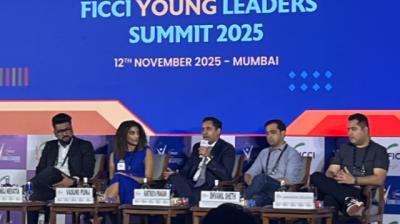How is AI changing the role of leadership? How can organisations integrate AI across business functions? These were the key themes discussed during a session at the FICCI Young Leaders Summit 2025.
Moderated by Ivinder Ray, executive director, Deloitte, the panel included Sumedha Chakraborty, country head, Google Workspace and Gemini, India and South Asia; Shruti Bhatia, head - AI workforce, Microsoft; Niraj Ruparel, creative technology lead, WPP; and Ankush Sabharwal, founder, BharatGPT, CoRover AI.
Setting the context of the discussion, Chakraborty voiced, “Every CXO needs to pivot when leading a workforce already empowered with AI. You need to have a workforce that understands AI or is enabled with AI to get from one innovation to the next.”
She pointed out that while many companies are experimenting with AI, only a small fraction have integrated it across their operations. “The future belongs to organisations where employees understand AI, can leverage it, and innovate continuously. Leadership needs to enable this from the ground up.”
Bhatia highlighted the shift from traditional people management to harnessing intelligence across workflows. “Leadership today is no longer about managing people but about tapping intelligence. It is not about adopting yet another tool but about ensuring that you are moving the organisation in a way that people know it’s the new way of operations. It's about building frameworks for responsible AI, fostering a culture of adoption, and moving fast.”
The conversation also addressed how AI is changing the very nature of technical work. Chakraborty noted that while AI can automate coding, the future of technology leadership lies in defining specifications and guiding product creativity rather than executing every line of code. “The emphasis will shift from coding to conceptualising, designing, and innovating. The future is not coding, it is specifications,” she explained.
“Agility is the first and foremost aspect for every leader to think about. That's one framework that should be there in all our models in the future,” she added.
Building on the perspective of leadership and organisational agility, Ruparel highlighted how AI can be harnessed to reach underserved populations.
“Today, many young leaders view AI as the most transformative force of our time. In my experience with Google, it struck me that while AI platforms are incredibly powerful, their benefits are often limited to urban, affluent audiences. Why not make them inclusive and reach the vast population at the bottom of the pyramid? In India, for example, over 350 million phone users still lack internet access or apps, and yet they are the ones who could benefit most from intelligent solutions,” he said.
Demonstrating AI’s transformative potential, Ruparel recalled the inception of ‘Telephone AI’. “To address this, we collaborated with multiple partners over two years to create a platform called Telephone AI. Our first project was with Perfetti’s Center Fruit, whose rural business, especially in Uttar Pradesh and Bihar, was largely disconnected from urban campaigns. Through Telephone AI, people could interact with the brand using even a basic phone, receiving creative, dynamic responses with each query.”
Sabharwal added that AI tools allow organisations to evolve without changing their core purpose or vision. “Companies don’t need to reinvent themselves completely. AI is a tool to amplify their objectives and drive impact efficiently,” he said.
The discussion then turned to how AI is reshaping talent management and organisational workflows.
Emphasising the importance of reskilling in today’s day and age, Bhatia said, “While there is a lot of debate about humans versus automation, it’s not about replacing humans. It’s about ensuring they remain relevant. Reskilling is imperative; either one reskills or becomes redundant. Organisations must move fast, adopt quickly, and embed AI across workflows. A typical CXO today is no longer just a leader — they are changemakers, championing innovation and enabling capacity for meaningful work through automation. Agility and speed have become the new currency.”
Citing how change management and skill-building are being approached systematically at Google, Chakraborty said, “We’ve launched multiple cloud programs at different levels—from students and young professionals to advanced users. Earlier this year, we embedded AI across all our Gmail offerings, paid and unpaid, so employees and users can learn on the job. When one has AI at their fingertips, they start experimenting, and the mindset shift begins to take place. Learning will happen faster than any training programs if AI is given to the users.”
Bhatia further elaborated on the need for function-specific skilling. “It’s not just about upskilling across a function or category; training has to be tailored to each function. Marketing teams, customer engagement teams, and technical teams - they all require different approaches. ”










